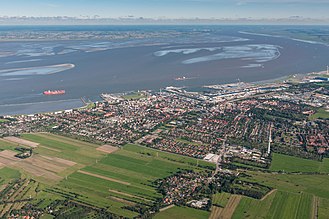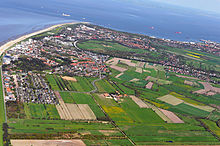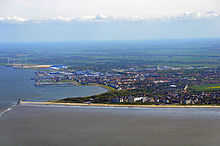Cuxhaven
![]()
The title of this article is ambiguous. For other meanings, see Cuxhaven (disambiguation).
Cuxhaven [ˌkʊksˈhaːfn̩] (Low German Cuxhoben) is a city at the mouth of the Elbe into the North Sea. It is the county seat of the district of the same name in Lower Saxony and, according to its number of inhabitants, is one of the large independent cities under the Lower Saxony Municipal Constitution Act. At the same time, it is the third largest city on Lower Saxony's North Sea coast after Wilhelmshaven and Emden, as well as the largest German seaside spa. The city belongs to the metropolitan regions of Northwest and Hamburg and is a medium-sized centre according to the state development plan.
The fishing port of Cuxhaven is one of the largest fishing ports in Germany. Until the end of 2008, the ship reporting station for Hamburg and for the Kiel Canal was located here. The spa business and tourism are of great economic importance in the North Sea spa of Cuxhaven.
The harbour settlement of Cuxhaven and the Amt Ritzebüttel, which was located on the present-day territory of the town of Cuxhaven, belonged to Hamburg from the 13th century until 1937. The then more important and larger Ritzebüttel and Cuxhaven merged in 1872 to form the town of Cuxhaven. Northwest of Cuxhaven, in the Hamburg Wadden Sea National Park, lies the North Sea island of Neuwerk, which belongs to Hamburg, with its side islands Nigehörn and Scharhörn.
Cuxhaven's landmark is the Kugelbake. The wooden sea marker marks the transition from the Lower Elbe to the Outer Elbe at the mouth of the Elbe and thus the border for inland shipping. The Kugelbake is also the motif of the coat of arms of the city of Cuxhaven.

Cuxhaven with Elbe, in the background Schleswig-Holstein
Geographical location and climate
Cuxhaven is located at the northern tip of Lower Saxony and is surrounded by water on two sides. The northernmost point of Lower Saxony is located in the district of Döse. This geographical location gives the town a special attraction for tourism, but also causes it special problems with regard to the economic connection to the hinterland.
The highest elevation in the town area is the Altenwalder Höhe (37.5 m above sea level); formerly the site of Altenwalder Burg on an old Saxon burial ground.
Due to the peripheral location and the historical affiliation of the city to Hamburg, two economic focal points developed: fishing and tourism. In addition to the core city, Cuxhaven comprises a number of incorporated villages spread over a comparatively large area. While the port developed from the old centre of Cuxhaven around the pilot quarter and Ritzebüttel Castle, the resorts of Döse, Duhnen and Sahlenburg, which are situated to the west of this centre and belong to the urban area, are the focus of tourism.
Cuxhaven has a humid climate with warm summers (Köppen-Geiger: Cfb). Due to the maritime location of the city, the summers are very mild in comparison to Central Europe; for example, the daily maximum temperature in August averaged only about 21.6 °C from 1991 to 2020.
| Cuxhaven | ||||||||||||||||||||||||||||||||||||||||||||||||
| Climate diagram | ||||||||||||||||||||||||||||||||||||||||||||||||
| ||||||||||||||||||||||||||||||||||||||||||||||||
| Climate data Cuxhaven
Source: DWD, September values: 1991-2016 and 2018-2020, precipitation in August: 1991-2018 and 2020, otherwise: 1991-2020. | |||||||||||||||||||||||||||||||||||||||||||||||||||||||||||||||||||||||||||||||||||||||||||||||||||||||||||||||||||||||||||||||||||||||||||||||||||||||||||||||||||||||||||||||||||||||||||||||||||||||||||||||
| Cuxhaven | ||||||||||||||||||||||||||||||||||||||||||||||||
| Climate diagram | ||||||||||||||||||||||||||||||||||||||||||||||||
| ||||||||||||||||||||||||||||||||||||||||||||||||
| Climate data Cuxhaven
Source: DWD, water temperature: reference period 1988-1995, otherwise: reference period 1961-1990 | |||||||||||||||||||||||||||||||||||||||||||||||||||||||||||||||||||||||||||||||||||||||||||||||||||||||||||||||||||||||||||||||||||||||||||||||||||||||||||||||||||||||||||||||||||||||||||||||||||||||||||||||||||||||||||||||||||||||||||||||||||||||||||||||||||||||||||||||||||||||||||||||||||||||||
At the end of the 20th and beginning of the 21st century, summers in Cuxhaven have become significantly warmer; if the daily maximum temperature in August was still about 20.1 °C on average for the years 1961-1990, it was about 21.6 °C for the reference period 1991-2020. Winters have also become milder; if the mean daily maximum temperature for the years 1961-1990 was about 3.0 °C in January, it was 4.5 °C for the period 1991-2020.
City breakdown
|
|
Neighboring communities
| Neuwerk district | ||
|
| Otterndorf | |
| Wurster North Sea coast | Neuenkirchen |

Spa areas

View from the North Sea, with Kugelbake on the left on the headland

View from the North Sea, with long sandy beach
Politics
Elections
The last local elections resulted in the following distribution of seats immediately after the election:
| Local election | CDU | SPD | TheCuxhavener | FDP | Green | The Left | Unaffiliated | AfD | Total |
| 11 September 2016 | 14 | 13 | 4 | 1 | 4 | 1 | - – | 3 | 40 seats |
| 11 September 2011 | 14 | 15 | 7 | 1 | 4 | 1 | - – | - – | 42 seats |
| September 10, 2006 | 16 | 14 | 3 | 3 | 3 | 1 | - – | - – | 40 seats |
| 09 September 2001 | 19 | 16 | 2 | 2 | 2 | - – | 1 | - – | 42 seats |
City Council
The council of the city of Cuxhaven consists of 40 members. This is the fixed number for a municipality with a population of between 40,001 and 50,000. The council is elected at municipal elections for five years at a time. The current term of office began on 1 November 2016 and ends on 31 October 2021.
The Lord Mayor is also entitled to vote in the Council.
Lord Mayor
→ Main article: List of mayors and lord mayors of Cuxhaven
Since 1 November 2019, Uwe Santjer (SPD) has been the full-time Lord Mayor, succeeding Ulrich Getsch. He won an absolute majority of 51% in the first round of voting against Harald Zahrte and Hans-Jürgen Wendt on 26 May 2019.
Coat of arms and flag
Since 20 December 1912, the town of Cuxhaven has officially had a town coat of arms. The Hamburg senator Emil Mumssen as lord of the manor of Ritzebüttel approved the coat of arms on 28 January 1913.
|
| Blazon: "The coat of arms of the city shows the black ball beacon, whose foot is washed by blue water, in a golden shield covered with a mural crown with three battlements." |
| Coat of arms reason: Klemens Stadler means to this in his book:
|
The flag of the city of Cuxhaven is white-red striped with the city coat of arms in the middle. The colors of the city are white-red.
Twinning
- France
 Vannes, France, since 1963
Vannes, France, since 1963 - United Kingdom
 Penzance, United Kingdom, since 1967
Penzance, United Kingdom, since 1967 - Iceland
 Hafnarfjörður, Iceland, since 1988
Hafnarfjörður, Iceland, since 1988 - Germany
 Binz and Sassnitz on Rügen, Germany, since 1990
Binz and Sassnitz on Rügen, Germany, since 1990
Since 1987 there was a town twinning with Nuuk, the capital of Greenland. Due to a territorial and administrative reform in Nuuk, it was terminated in March 2011.
Friendships between cities
- Poland
 Piła, Poland, since 1996
Piła, Poland, since 1996 - Spain
 Vilanova de Arousa, Spain, since 2001
Vilanova de Arousa, Spain, since 2001 - Portugal
 Ílhavo, Portugal, since 2002
Ílhavo, Portugal, since 2002 - Russia
 Murmansk, Russia, since 2004
Murmansk, Russia, since 2004
.jpg)
City Hall Cuxhaven
Search within the encyclopedia
.svg.png)
